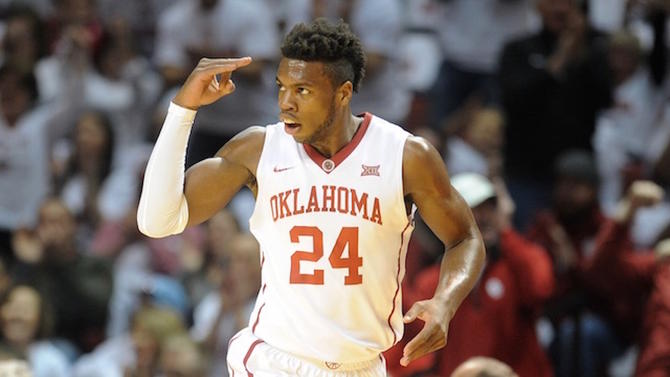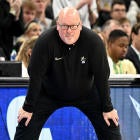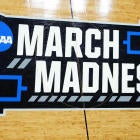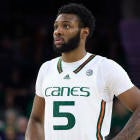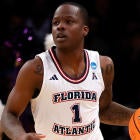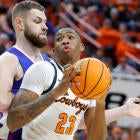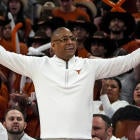Over the next week, NBA Draft Expert Sam Vecenie is releasing his positional draft rankings to pair with mini scouting reports on each of the top 10 players at each position. That will be followed by the next 10 on his board.
Each position will also be broken into tiers in order to help consumers understand how the players break down in terms of similar talent levels. For each player in each tier, it's often scheme-based in terms of which team fits each player best.
Today, we break out the shooting guards. Really, we could put the shooting guards and some of the small forwards together as "wings," but doing them separately might help break out some further players. Of note here: there is no true Tier 1 player in this class. Some might throw Jamal Murray into that classification, but at this stage he still has quite a bit to prove on both ends in order to earn that.
Also worth pointing out is the relative strength through the first round, with seven players rating in the top 30, as well as the weakness throughout the rest of the group with only 15 in the top 75 and two players making the top 20 outside of the top 100.
TIER 2
1. Jamal Murray | Kentucky | 6-5, 204 pounds, 6-7.5 wingspan, 19 years old
Murray is just about guaranteed to be a top 10 pick in this draft -- probably a top-six pick -- after a record-setting season at Kentucky. The guard set the freshman scoring record at the storied institution, scoring 20 points per game with a 59.0 true-shooting percentage that included knocking down 41 percent of his 3s. Particularly, Murray excelled knocking down shots off of the catch, hitting his 193 attempts at a prodigious 68.1 effective field goal percentage. Among the 130 players nationally to take at least 50 shots coming off of screens, Murray was second-most efficient, hitting them at a 78.7 effective field goal percentage. Basically, Murray is about as an elite a shooter as you'll find coming off of the catch, something that should translate well to the NBA no matter what given the emphasis on spacing.
Where Murray will try to differentiate himself as a prospect is by developing his game on-ball and on the defensive end. The former Kentucky guard showed great potential as a ball-handler in his prep days, putting on display his ability to change speeds and direction as well as solid vision and passing acumen. Unfortunately, that's not something he was able to do at Kentucky due to the lack of spacing around him. Teams drafting Murray as highly as he is expected to go will be looking for the increased spacing of the NBA game (due to the extended 3-point line) to help out Murray's ability to create plays off the bounce. If he can do that, he has potential to be an all-star caliber offensive force. I say offensively there because defensively he's nowhere even near that. He hasn't shown any capacity at this stage to be an effective NBA defender -- including substandard length, average quickness laterally, suboptimal effort.
As a believer in Murray's game with the ball in his hands, I have him rated at the No. 6 player in the draft. But the questions hold him back from entering that Tier 1 level. Debate will rage as to whether or not he's the best shooting guard in the draft (along with the next player), but the three-plus year age difference is a big differentiator for me.
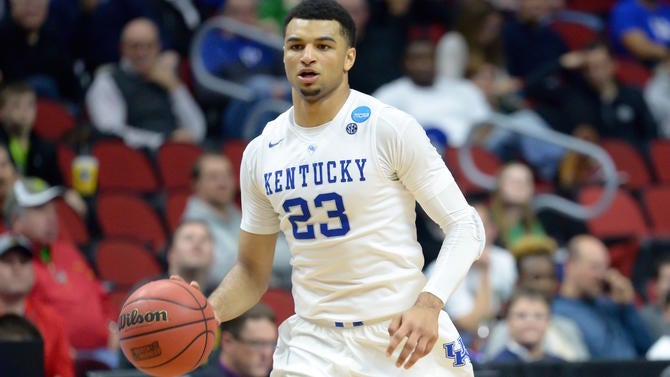
2. Buddy Hield | Oklahoma | 6-5, 212 pounds, 6-9.25 wingspan, 22 years old
Hield was the CBS Sports Player of the Year this season after leading Oklahoma to the Final Four. What can even be said about the absurd display Hield put up this season? He had a 50.1/45.7/88 shooting line, the first of its kind in college hoops in at least the last 25 years while averaging at least 24 points per game. Anytime you're doing things that haven't been done in 25 years in terms of both volume and efficiency, you're doing something right.
Simply put, Hield has worked himself into becoming an elite shooter. He hits them off of the catch, off of the dribble by creating separation with a step-back (almost always to the left), and on the move. Hield also improved his dribble immensely this season, and the place he uses it best at this juncture is to keep his dribble alive. He's not necessarily elite in terms of creating his own shots at the rim or getting to the lane, but he does good work keeping things going until he can break down a player and get some space for that elite jumper. When he does get to the rim in the half court though, he finishes well, putting up a 59.2 percent true rim rate (that is, percentage within three feet of the rim minus transition opportunities, put-backs, and post-ups in order to distill the strength of a player's ability to finish in traffic on drives or cuts in half court settings).
Hield can still get better off the dribble, where the ability to attack in a more well-rounded manner might be able to help him take the leap to Tier 1 as a prospect. Also, he needs to improve his defensive energy. As a sophomore, Hield showed much in the way of slowing down opposing wings, and he's always at the very least attentive and makes rotations. However, he needs to be able to show the better energy level that he did when he was young more consistently in order to become an elite player. He and Murray are neck and neck for the top spot here, but ultimately I side with Murray due to the upside of his age.
TIER 3
3. Denzel Valentine | Michigan State | 6-6, 210 pounds, 6-10.75 wingspan, 22 years old
When we look back on what Valentine just did during his senior year at Michigan State, we're going to think of it as one of the elite college basketball seasons of the last couple of decades. To begin, he became the first player since 1984 (when assists became an official stat tracked in college hoops) to put up 19 points, seven rebounds and seven assists per game. He did it while hitting 44 percent of his 3s, putting up the second-highest assist rate in college hoops, and an insanely efficient 60.8 true-shooting percentage. That's a legendarily good college basketball season.
In terms of how all that skill translates to the next level, I think we're talking about a potentially elite role player that could easily make nine figures throughout his career -- if he goes to the right situation. There are few players in this draft as scheme-dependent as Valentine. On one hand, he's a highly-intelligent player with great vision on the floor who can really knock down shots and move away from the ball. It's easy to imagine him slinking right into a role in a place like Golden State or San Antonio -- motion-heavy offenses -- quickly and becoming an awesome player. But if he goes to a situation more reliant on isolation scoring, that's where things get dicey. He's a very average athlete who can handle the ball a bit, but it's questionable how that'll work in the NBA. Defensively, he's smart, long, and typically in the right spots, but he's also not great at cutting off penetration one-on-one.
The shooting will be there, and so will the playmaking. That will carve out a role for him in some capacity. But just how high-end of a player he can be will be scheme dependent.
4. Timothe Luwawu | Mega Leks (Serbia) | 6-7. 205 pounds, 6-11 wingspan, 21 years old
Luwawu has one of the more volatile stocks in the draft among people around the league. Some consider him a potential late lottery pick, others think he's more of a late first rounder. The 6-7 wing has taken a nice step forward this season in Serbia after moving there from France, improving in all capacities as an offensive player. He has become a better ball-handler, scorer, and even shooter from distance. He's in the top-five in scoring in the Adriatic League -- no small feat -- and also possesses quite a bit of potential on the defensive end due to his hustle, length, and quickness.
Still, some look at the jump shot with its low release point and wonder if it will translate to the NBA. Others ask if his frame will fill out enough to play both wing positions consistently enough to grow into the 3-and-D player they hope he can become. Still, it'd be a surprise if Luwawu fell out of the top 20 on draft night given what he has in the toolbox at this stage in terms of athleticism and rudimentary yet productive scoring capabilities. He has enough fans around the league that someone will likely take the plunge early.
5. Furkan Korkmaz | Anadolu Efes (Turkey) | 6-7, 185 pounds, 18 years old
Korkmaz is an interesting player that -- as reported by The Vertical/DraftExpress -- may or may not end up staying in the draft depending on if he can get assurances that he'll go high enough. To begin, Korkmaz is bouncy, with the ability to take off with only one or with two feet and can finish above the rim.
It's fair to say that the rest of his game isn't necessarily as explosive, though. Korkmaz is mobile and a solid athlete, but he's definitely more of a highly skilled player than a highlight machine due to his shooting ability. He's hit 42 percent of his 3s at Anadolu Efes since moving there in 2014, and hit 45 percent of them playing up in a higher age group in the U19 World Championships last summer. He was named to that competition's all-tournament team, as well as the all-tourney team for the U18 European competition later that same summer. He's a smart passer, plays within a team concept well, and should provide offensive value at some point in his NBA career.
The biggest question at this stage is his frame. As you can see with a guy who weighs 185 pounds at 6-foot-7, Korkmaz is extremely skinny and that hinders him in terms of embracing contact inside and finishing as well as on the defensive end where he's just bullied around. If a team believes they can improve his frame, he's worth a top-20 pick.
6. Malik Beasley | Florida State | 6-5, 190 pounds, 6-7 wingspan, 19 years old
Beasley was not necessarily expected to be Florida State's one-and-done this season, but he earned that right after a superb freshman campaign that saw him finish seventh among high-major freshmen in scoring this season at 15.4 points per game. He did so efficiently, showing off a mature, intelligent offensive game that can hurt opposing defenses from all three levels, as his shooting chart shows.
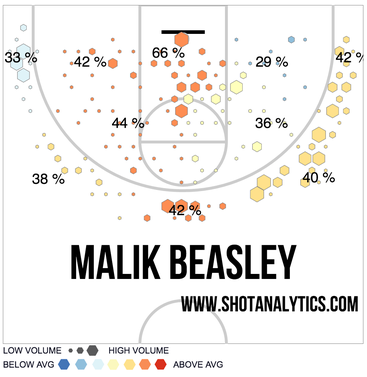
The impressive thing about that chart isn't necessarily hyper-efficiency around the rim, or superb 3-point shooting. Rather, it's the ability to score from nearly any spot on the floor efficiently. He hits shots off the dribble or off the catch. He has the ability to create plays off of closeouts. He has a solid little runner/floater that he uses in the lane when teams cut off the rim. He has some experience handling and creating out of the pick-and-roll.
There are two places where Beasley needs to improve though. First, he's not a particularly good finisher in half court settings. The above chart shows him making 66 percent of his shots around the basket, however that number is inflated by his proficiency at getting out in transition and attacking the offensive boards. His true rim rate this past season was 41.6 percent, a low number for a wing that likely owes to him being a bit undersized. Also, he could stand to improve his tenacity on defense. The size is a question mark, but he's a first-round level talent.
TIER 4
7. Malcolm Brogdon | Virginia | 6-6, 223 pounds, 6-10.5 wingspan, 23 years old
Brogdon kicks off a new tier here. There might not be a more mature player in this draft than Brogdon, who knows exactly what he is and what he can bring to an NBA team. The first-team All-American this season from Virginia took a big step forward in terms of his shooting efficiency, potentially paving the way for a long career in the NBA.
When discussing Brogdon's NBA potential, the first thing you have to discuss is his defense. Brogdon has been the best wing defender in college basketball for each of the last two seasons, utilizing his strength, length, and intelligence to force even the most elite offensive players off of their spots and into uncomfortable positions. He does most of his work before the ball even gets to the defender by moving him away from where he wants to go, then contests shots well due to his length and massive hands. If there is a wing in this draft that has NBA All-Defense potential, it's Brogdon.
Offensively is where things get a bit more precarious. The 6-6 guard has what can be referred to as an old man's game due to his lack of lift and elevation. He gets by with skill and guile, utilizing solid change of pace and direction in his dribble as well as terrific off-ball movement. He was great in situations off the catch this year, converting at a 56.4 effective field goal percentage, and also did a good job of finishing around the basket due in large part to his intelligence cutting toward it. He converted shots around the basket at a 57.2 true rim rate, a great percentage for wings. What scouts question is whether or not the lack of explosiveness will be a problem, and whether or not his jump shot will translate due to the fact that it's a bit flat with a slightly funky release. Still, Brogdon is a high character kid that teams will likely want to get into their locker room, and his defensive potential is extremely high.

8. Patrick McCaw | UNLV | 6-7, 181 pounds, 6-10 wingspan, 20 years old
McCaw has decided to go to the NBA after a pair of solid, yet inconsistent seasons at UNLV that saw him rise from the level of a three-star recruit to the precipice of the professional ranks, but also never quite put together his total skill set on a night-to-night basis.
On the plus side, McCaw is a long, highly intelligent player who is extremely productive due to those skills. Defensively, there are few better players at getting into passing lanes for steals, as his anticipation is off the charts. He genuinely creates transition opportunities due to this skill, a highly valuable commodity in the NBA. He also is extremely laterally quick, and seems to enjoy playing on that end of the floor. That quickness and length allows him to play against 1s or 2s with a high level of effectiveness now, and it's not hard to imagine him moving down to play against 3s at some point if he can continue to add strength.
Offensively is where things are a bit more up in the air. McCaw can hit the open look off the catch, but it's still not quite consistent enough for me to call that skill a plus. He's a good creator for his teammates on offense due to his vision of the court, but it's easy to knock him off his line when slashing due to his lack of strength. He finished in the half court at a solid 50 percent true rim rate, but it's easy to imagine that not translating super well to the next level due to his lack of strength. If you're a person who believes that McCaw still has some room to grow into in terms of his body, you probably like him as a late first round pick due to the value he could potentially provide as a 3-and-D player who can actually move the ball a bit on offense. If you don't, he's probably more of a mid-to-late second rounder due to the inconsistency that will plague his game.
9. Isaia Cordinier | Denain (France) | 6-5, 177 pounds, 6-8 wingspan, 19 years old
Cordinier is still a project. That much is clear. But there is some significant upside, and there are some overseas who believe Cordinier may have a better long-term future than the French player ranked above him here in Timothe Luwawu.
Cordinier is an athletic, bouncy two guard who can shift into a playmaking role at the 1 on occasion due to his high level basketball IQ and tremendous vision. Long-term, he's seen as a scoring guard due to his shooting and slashing ability, but his passing shouldn't be overlooked as a smart team player who plays the way teams are looking for today in terms of ball movement.
This season, his first at Denain, Cordinier is putting up a superb 46.3/40.4/77.9 shooting line as a 19 year old, scoring 10.8 points per game. He also possesses shiftiness and an understanding of change of pace that should project well once he develops further in terms of handling the ball consistently. He's far from a perfect prospect, as his lack of strength -- particularly in his lower body -- makes him a likely stash prospect in Europe for at least a year or two. But with some further development of his clear talent, it's not hard to imagine him bursting onto the scene over there before becoming an NBA player. If he stays in the draft, the team that takes him will be playing more of a long game.
10. Malachi Richardson | Syracuse | 6-6, 200 pounds, 7-0 wingspan, 20 years old
Richardson is an interesting player in that he's seemingly much higher on some NBA teams' boards than he is on mine. The positives are evident. He's a 6-6 player with long arms who can create his own shot well. Those wing players are highly sought after and valuable in today's NBA. He also has some defensive potential due to his length and quickness, although there will be an adjustment period for him at the NBA level after playing in the Syracuse zone in the college game.
However, the negatives are equally as strong. While Richardson can create his own shot, he has a propensity to take bad shots of the midrange, step-back, pull-up variety. He shot 37 percent from the field this season, including only 39 percent from 2-point range. He took a ton of wild looking shots at the rim and doesn't play above it despite the length and vertical leap that says he should. He didn't really show much in the way of playmaking for others due to his ball-stopping tendencies, and posted a slightly negative assist-to-turnover ratio. Basically, Richardson at this stage is an inefficient gunner with room for growth that is riding high off of a hot NCAA Tournament. Throw in the fact that he's older than four of the nine college sophomores projected to get drafted this season, and it puts a bit of water on the idea of him being a freshman that is still learning and developing.
My read on the situation is that someone is going to take him in the first round. He's a highly volatile prospect in terms of where the teams I've spoken with have him slotted (anywhere from mid-first to mid-second), but my guess is someone falls in love with the upside and takes a shot. Personally though, I'm not a fan of paying for the small sample that is the NCAA Tournament, and thus do not have him graded in the first round.
Next 10: (Tier 5, continued) Sheldon McClellan, Miami (Fla.); Caris LeVert, Michigan, Michael Gbinije, Syracuse; Wayne Selden, Kansas; Damion Lee, Louisville
(Tier 6) Daniel Hamilton, Connecticut; Blaz Mesicek, Union Olimija (Slovenia); Tim Quarterman, LSU
(Tier 7) Bryn Forbes, Michigan State; David Walker, Northeastern
